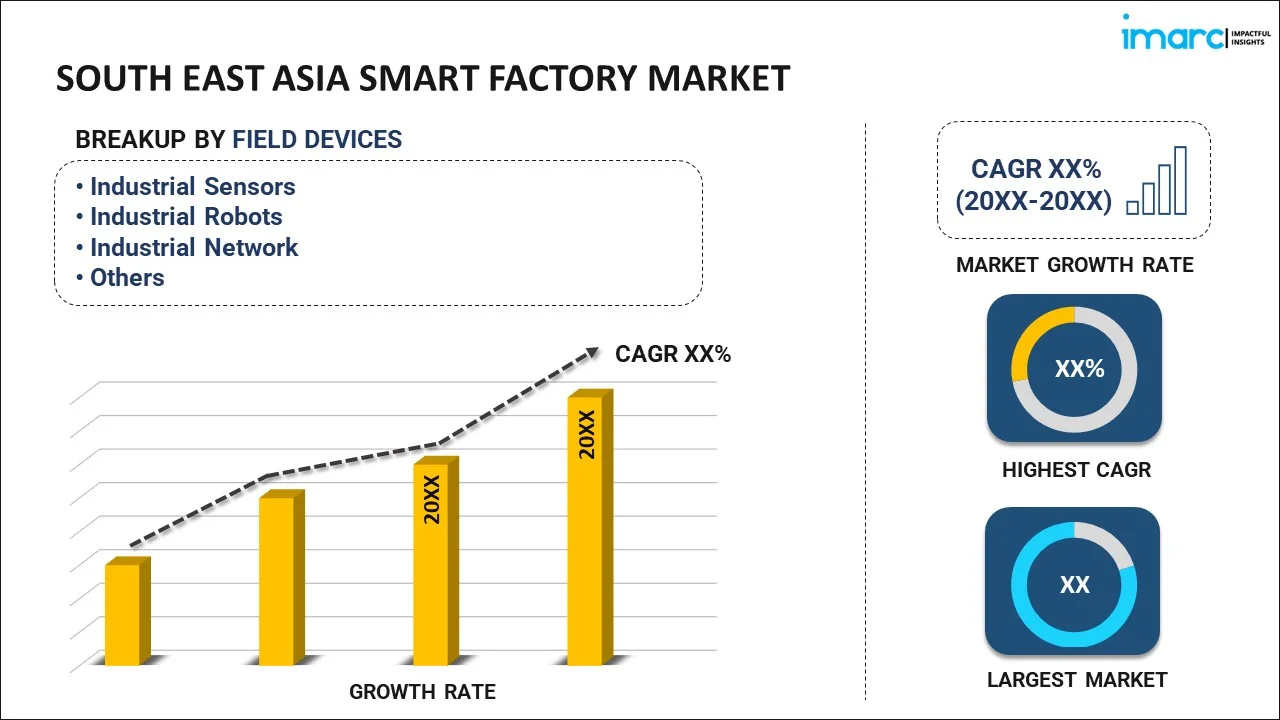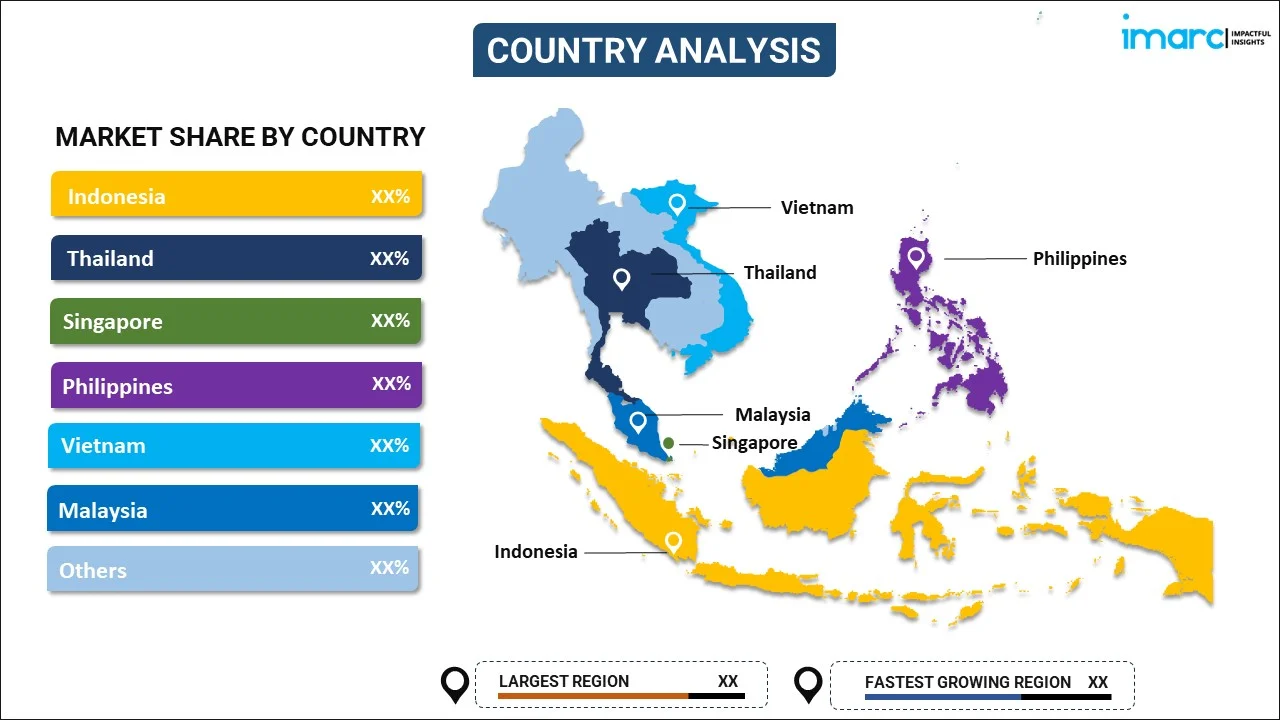
South East Asia Smart Factory Market Report by Field Devices (Industrial Sensors, Industrial Robots, Industrial Network, Industrial 3D Printers, Machine Vision Systems), Technology (Product Lifecycle Management (PLM), Human Machine Interface (HMI), Enterprise Resource Planning (ERP), Manufacturing Execution Systems (MES), Distributed Control Systems (DCS), Industrial Control System, and Others), End Use Industry (Pharmaceuticals, Food and Beverages, Chemical, Oil and Gas, Automotive and Transportation, Semiconductor and Electronics, Aerospace and Defense, and Others), and Country 2024-2032
Market Overview:
South East Asia smart factory market size is projected to exhibit a growth rate (CAGR) of 9.50% during 2024-2032. The deployment of robots and automated systems in manufacturing processes, which improve precision, speed, and consistency, is driving the market.
|
Report Attribute
|
Key Statistics
|
|---|---|
|
Base Year
|
2023 |
|
Forecast Years
|
2024-2032
|
|
Historical Years
|
2018-2023
|
| Market Growth Rate (2024-2032) | 9.50% |
A smart factory is a technologically advanced manufacturing facility that leverages the integration of cutting-edge technologies such as the Internet of Things (IoT), artificial intelligence (AI), machine learning, and automation to optimize and enhance the entire production process. In a smart factory, machinery and equipment are interconnected, allowing real-time data exchange and analysis to improve efficiency, productivity, and decision-making. This interconnectedness enables seamless communication between different components of the production line, leading to predictive maintenance, reduced downtime, and optimized resource utilization. The use of data analytics in a smart factory enables proactive problem-solving and continuous improvement, ultimately resulting in a more agile and responsive manufacturing environment. The goal is to create a highly adaptive and intelligent production system capable of meeting dynamic market demands while maintaining high-quality standards and cost-effectiveness.
South East Asia Smart Factory Market Trends:
The smart factory market in South East Asia is experiencing robust growth, primarily driven by advancements in technology and increasing demand for automation across industries. Firstly, the integration of industrial IoT has been a pivotal driver, connecting machines and devices to enhance data exchange and real-time monitoring. Consequently, this connectivity enables predictive maintenance, reducing downtime and optimizing overall operational efficiency. Additionally, the adoption of AI and machine learning further amplifies the smart factory landscape. These technologies empower decision-making processes, allowing for adaptive and self-optimizing production systems. Furthermore, the growing emphasis on cost reduction and resource efficiency propels the smart factory market forward. Automation streamlines manufacturing processes, leading to reduced labor costs and minimized material waste. This cost-effectiveness becomes a compelling factor for industries striving to enhance their competitiveness in the regional market. Moreover, the increasing awareness of sustainability and environmental concerns contributes to the rise of smart factories, as optimized processes inherently lead to a reduction in energy consumption and carbon footprint. In summary, the convergence of technological innovations, cost-saving imperatives, and sustainability goals collectively propel the smart factory market in Southeast Asia, shaping the future of industrial production.
South East Asia Smart Factory Market Segmentation:
IMARC Group provides an analysis of the key trends in each segment of the market, along with forecasts at the regional and country levels for 2024-2032. Our report has categorized the market based on field devices, technology, and end use industry.
Field Devices Insights:

- Industrial Sensors
- Industrial Robots
- Industrial Network
- Industrial 3D Printers
- Machine Vision Systems
The report has provided a detailed breakup and analysis of the market based on the field devices. This includes industrial sensors, industrial robots, industrial network, industrial 3D printers, and machine vision systems.
Technology Insights:
- Product Lifecycle Management (PLM)
- Human Machine Interface (HMI)
- Enterprise Resource Planning (ERP)
- Manufacturing Execution Systems (MES)
- Distributed Control Systems (DCS)
- Industrial Control System
- Others
A detailed breakup and analysis of the market based on the technology have also been provided in the report. This includes product lifecycle management (PLM), human machine interface (HMI), enterprise resource planning (ERP), manufacturing execution systems (MES), distributed control systems (DCS), industrial control system, and others.
End Use Industry Insights:
- Pharmaceuticals
- Food and Beverages
- Chemical
- Oil and Gas
- Automotive and Transportation
- Semiconductor and Electronics
- Aerospace and Defense
- Others
The report has provided a detailed breakup and analysis of the market based on the end use industry. This includes pharmaceuticals, food and beverages, chemical, oil and gas, automotive and transportation, semiconductor and electronics, aerospace and defense, and others.
Country Insights:

- Indonesia
- Thailand
- Singapore
- Philippines
- Vietnam
- Malaysia
- Others
The report has also provided a comprehensive analysis of all the major regional markets, which include Indonesia, Thailand, Singapore, Philippines, Vietnam, Malaysia, and Others.
Competitive Landscape:
The market research report has also provided a comprehensive analysis of the competitive landscape in the market. Competitive analysis such as market structure, key player positioning, top winning strategies, competitive dashboard, and company evaluation quadrant has been covered in the report. Also, detailed profiles of all major companies have been provided.
South East Asia Smart Factory Market Report Coverage:
| Report Features | Details |
|---|---|
| Base Year of the Analysis | 2023 |
| Historical Period | 2018-2023 |
| Forecast Period | 2024-2032 |
| Units | US$ Million |
| Scope of the Report | Exploration of Historical and Forecast Trends, Industry Catalysts and Challenges, Segment-Wise Historical and Predictive Market Assessment:
|
| Field Devices Covered | Industrial Sensors, Industrial Robots, Industrial Network, Industrial 3D Printers, Machine Vision Systems |
| Technologies Covered | Product Lifecycle Management (PLM), Human Machine Interface (HMI), Enterprise Resource Planning (ERP), Manufacturing Execution Systems (MES), Distributed Control Systems (DCS), Industrial Control System, Others |
| End Use Industries Covered | Pharmaceuticals, Food and Beverages, Chemical, Oil and Gas, Automotive and Transportation, Semiconductor and Electronics, Aerospace and Defense, Others |
| Countries Covered | Indonesia, Thailand, Singapore, Philippines, Vietnam, Malaysia, Others |
| Customization Scope | 10% Free Customization |
| Report Price and Purchase Option | Single User License: US$ 3699 Five User License: US$ 4699 Corporate License: US$ 5699 |
| Post-Sale Analyst Support | 10-12 Weeks |
| Delivery Format | PDF and Excel through Email (We can also provide the editable version of the report in PPT/Word format on special request) |
Key Questions Answered in This Report:
- How has the South East Asia smart factory market performed so far and how will it perform in the coming years?
- What has been the impact of COVID-19 on the South East Asia smart factory market?
- What is the breakup of the South East Asia smart factory market on the basis of field devices?
- What is the breakup of the South East Asia smart factory market on the basis of technology?
- What is the breakup of the South East Asia smart factory market on the basis of end use industry?
- What are the various stages in the value chain of the South East Asia smart factory market?
- What are the key driving factors and challenges in the South East Asia smart factory?
- What is the structure of the South East Asia smart factory market and who are the key players?
- What is the degree of competition in the South East Asia smart factory market?
Key Benefits for Stakeholders:
- IMARC’s industry report offers a comprehensive quantitative analysis of various market segments, historical and current market trends, market forecasts, and dynamics of the South East Asia smart factory market from 2018-2032.
- The research report provides the latest information on the market drivers, challenges, and opportunities in the South East Asia smart factory market.
- Porter's five forces analysis assist stakeholders in assessing the impact of new entrants, competitive rivalry, supplier power, buyer power, and the threat of substitution. It helps stakeholders to analyze the level of competition within the South East Asia smart factory industry and its attractiveness.
- Competitive landscape allows stakeholders to understand their competitive environment and provides an insight into the current positions of key players in the market.
Need more help?
- Speak to our experienced analysts for insights on the current market scenarios.
- Include additional segments and countries to customize the report as per your requirement.
- Gain an unparalleled competitive advantage in your domain by understanding how to utilize the report and positively impacting your operations and revenue.
- For further assistance, please connect with our analysts.
 Inquire Before Buying
Inquire Before Buying
 Speak to an Analyst
Speak to an Analyst
 Request Brochure
Request Brochure
 Request Customization
Request Customization




.webp)




.webp)












